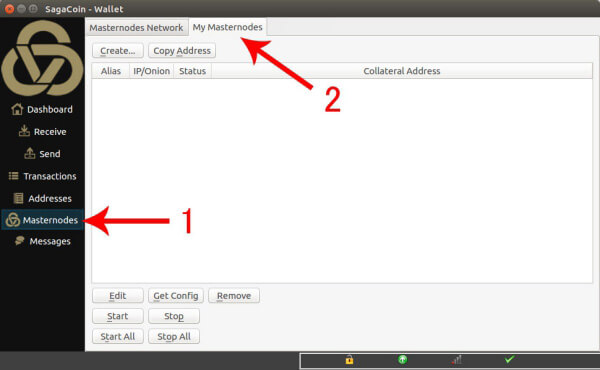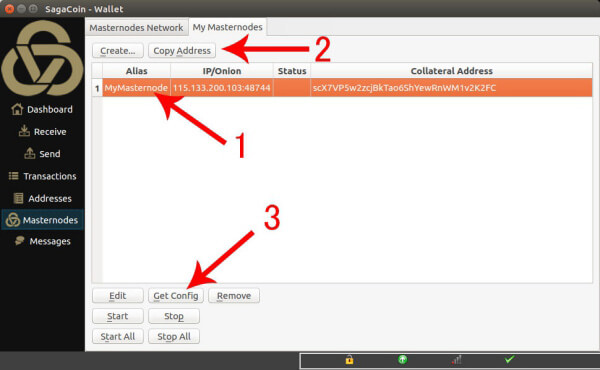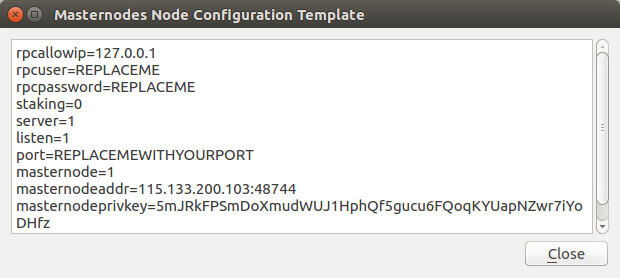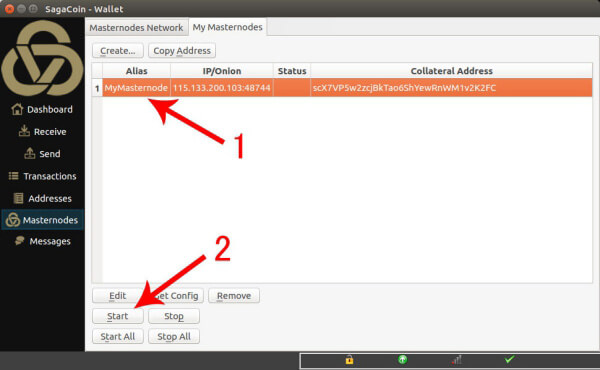Bonded validator systems, also known as masternodes, are a group of servers that support blockchain networks.
They are parts of the network that enable services and actions that miners can not provide in a Proof of Work scenario.
The first currency to enable masternodes on it’s platform was DASH, using a two-tier verification system that ensures an evenly distributed consensus on voting.
After proving itself on the DASH network, masternodes have been adopted by a variety of different cryptocurrencies and are used as an incentive driven way to maintain the network.

How Do Masternodes Work?
Much like a Proof of Stake situation, masternodes require you to stake a certain amount of the currency or token in order for it to run.
The minimum amount and worth vary significantly between currencies.
For example, DASH requires 1000 coins, currently worth $500,000, to start a masternode.
On the other hand, SAGA requires 2500 coins, currently worth $3,200, to begin.
The majority of masternodes run off of the currency’s core wallet, I will go over instructions later, but once it is setup and your wallet(s) contain the correct balance, your masternode is live.
Compensation and payouts also vary based on the currency, a lot of masternodes will pay you out well over 100% of your original investment in the first year.
While your masternode is paying out, you will still have your original stake of coins that you can sell when you no longer want the masternode to run, however dropping below the minimum required amount of currency, will cause the masternode to stop functioning.
So, if you still want payouts every so often, make sure you keep the original amount in the wallet.
Masternodes blockchain security works similarly to that of Proof of Stake.
They protect the network from attacks and serve some other great purposes as well.
Masternodes aim to keep the blockchain decentralized with voting weight by making it too expensive for any one person to hold the vast majority of masternodes.
This also keeps the holders of masternodes generally honest with their stake as they have a high cost of operation and typically satisfying payouts, this incentivizes anyone running a masternode to follow the rules and maintain it properly.
Some huge benefits are nearly instant transactions, anonymous payments, and decentralized governance and voting rights.
Shared Masternodes
If you want to get into a certain masternode currency and do not have the capital necessary to start a masternode, shared masternodes might be for you.
Basically, you and several other people would have a percentage of the whole masternode requiring less capital.
The manager of the node would then pay you out, typically on a weekly basis, for what your portion obtained.
The downside to shared masternodes is that the managers usually take a cut of your profits since they are running it and giving you the opportunity to risk less capital.
Cryptocurrencies such as DASH have a lot of shared masternodes due to their extremely high cost minimum balance.
Compounding and Interest
You see that masternodes sort of work like dividends, paying you out from holdings.
However, masternodes do not pay out more as your balance increases, meaning it does not compound.
Since most masternode coins use a Proof of Stake algorithm, you can use your earnings to do a regular stake on the network so your payouts from masternodes can actually achieve more earned tokens, without much work.
Masternodes benefit over miners given that you can sell your original stake for whatever it’s worth that the time, whereas selling a used miner after a few years would be very difficult as it would become less profitable overtime.
Why Are Masternodes Good?
Masternodes are the solution to many issues that Proof of Work systems present, and act as a better version of Proof of Stake systems.
They avoid the centralizing issues of Proof of Work and mining as well as consume far less electricity and resources than mining does.
They are even used to regulate some miners in Proof of Work systems such as DASH’s, where they monitor miners transactions and activity to ensure verification.
Getting Into Masternodes
There are several cryptocurrencies I’ve researched and looked into masternodes for including SAGA, PIVX, ChainCoin, Syscoin and many more.
A lot of them have proven to have great platforms and are actually cryptocurrencies I would invest in.
That is a trait you should look for in masternodes coins as well, since you’ll have to be holding them for extended periods of time.
It’s important you choose a coin you believe in, but here are some to look into if you’re getting started.
- SagaCoin – A cryptocurrency focusing on using masternodes in order to make a decentralized system that can be globally used in the future. 2,500 SAGA required to start.
- PIVX – A renown privacy coin that uses masternodes for their fast, secure, and most of all, private transaction to make an anonymous network. 10,000 PIVX required to start.
- ChainCoin – Takes advantage of the speed and security masternodes can offer, making a good cryptocurrency with fast and secure transactions. 1,000 CHC required to start.
- Syscoin – A corporate rounded cryptocurrency using a decentralized and secure marketplace with no middleman, peer to peer. 100,000 SYS required to start.
- SmartCash – Another privacy coin based around decentralized governance and voting rights on the blockchain. 10,000 SMART required to start.
- VeChain – VeChain offers a “robust economic model” for decentralized digital currencies as well as Internet of Things integration. 10,000 VET required to start.
- ZCoin – Secure and private financial transactions, using cryptographic proofs to ensure a verified blockchain and hasty transaction speeds. 1,000 XZC required to start.
- ALQO – Offers instant private transaction as a 3rd generation cryptocurrency, using masternodes and their benefits to create a secure method of transaction. 10,000 ALQO required to start.
As you can see the minimum required amount varies through each currency, and they all have different methods of running a masternode.
Masternodes all run on a basic level, pretty similarly. I’ll go over a few things to get started.
VPS
First thing you’ll need is a Virtual Private Server (VPS). It’s basically a virtual machine running some operating system that you’ll put your wallets on.
Using a VPS opposed to your home system increases security as you likely don’t have any sort of network security set up passed the basics.
I recommend using Linux on your VPS as it’s more reliable, but if you’re not familiar with Linux operating systems, use a Windows VPS.
This will cost you a little bit a month, probably about $10-20 but your masternodes should easily cover that.
Choose a Coin
Once your VPS is up and running, you’ll need to choose a coin to start with.
For example, I chose SagaCoin, so navigate to the cryptocurrency’s official site and download the core wallet.
Once it is downloaded, run it on the host machine or VPS and let it sync with the network, this usually takes a few hours, sometimes far longer depending on the blockchain.
Fortunately, most wallets use qt so the GUI is similar and has the same functions.
Here are some steps for SagaCoin masternode found in their guide.

Once the wallet is in sync with the network, open it up, navigate to Masternodes then My Masternodes on the bar.

Click Create and under Alias name the node whatever you want, then under Address put your external IP followed by the Port the coin uses for masternodes, in the case of Saga, it is 48744.

Now you can copy the address of the masternode, and send EXACTLY the required amount and adjust for the fee, for SagaCoin we sent 2500 to the address, different coins will be a different amount.
Once that has begun, click Get Config to setup the config.

You have to replace your port assigned to this masternode at REPLACEMEWITHYOURPORT.
The configuration file contains first 3 lines by default (rpcallowip, rpcuser, rpcpassword), so you just require to copy 4th lines onwards and paste to sagacoin.conf file.
You may your sagacoin.conf at:
- Linux: ~/.SagaCoin/sagacoin.conf
- Windows: C:\Users\[username]\AppData\Roaming\SagaCoin\sagacoin.conf
- Mac: /Users/[username]/Library/Application Support/Bitcoin/sagacoin.conf

Once you have adjusted your config, navigate back to Masternodes, then My Masternodes, and click Start.
If you did everything correctly, it should start that this point.
If you’re hosting from a personal machine, you may need to open a port on the firewall, this can be the case on VPS’ as well.
Cases vary on ports for different coins.
Should You Get Into Masternodes?
Just like any other investment, you should always like what you’re contributing to.
Masternodes can offer great payout potential and profits, alongside the bonus that you can still sell your original holdings whenever you decide you don’t want payouts anymore.
All while contributing to the next step in the cryptocurrency revolution by reducing energy usage and preventing fraudulent activities and malicious attacks.
This is typically a lower risk than pursuing mining since you don’t have to use capital to buy machines, and instead only hold coins.
Wanna buy snacks for my dogs?
BTC – 1K3GsVLnRR49Hpt5VBFVVKasKuFAbnuLS5
LTC – LhqmMLT8pXb3Xn8D29HDhdFkDHvittHP39
ETH – 0x6f2e8022Cf20C97FE93EbD6fBaBFf856232E4F14
